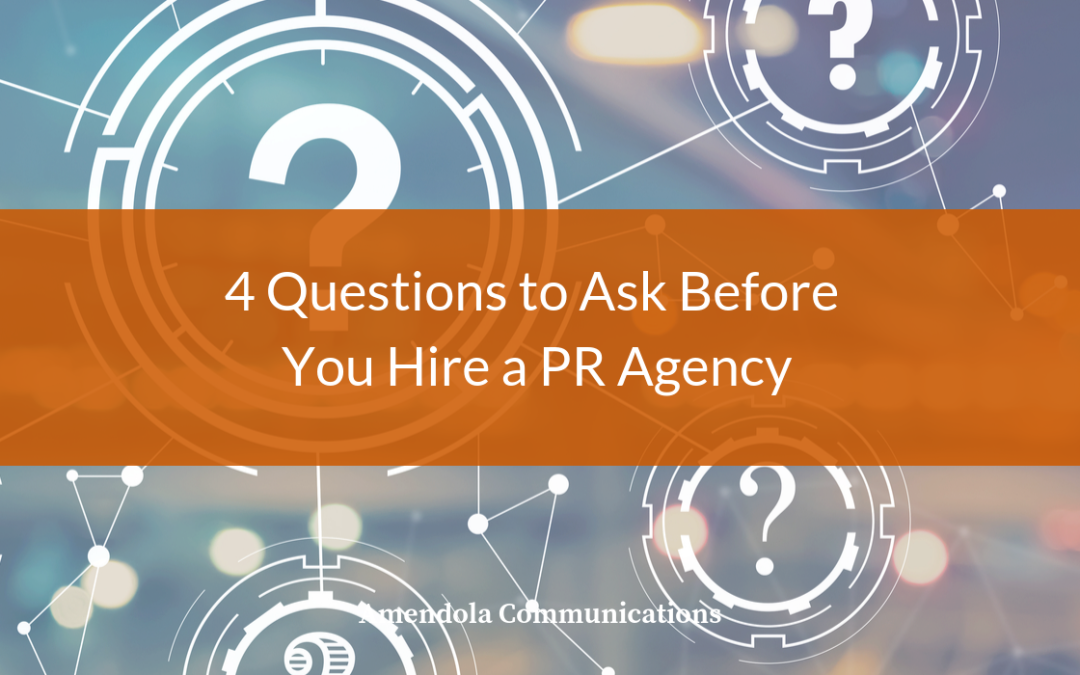
by Jodi Amendola | Oct 16, 2019 | Blog
There are many great reasons companies hire a PR agency.
Start-ups often do it to create a “larger than life” image in the marketplace. Having your executives interviewed by top industry trade media, or having your thought leadership published in top publications, helps build brand awareness and elevates the perception of the company’s position in the industry – an important factor when selling against larger, more established competitors. There’s nothing like having an industry analyst tell a small client they thought the client was much larger based on all the publicity they’ve received.
More established organizations may hire a PR agency to help change a negative perception into a positive one. They may do it to help generate sales leads or provide “air cover” for salespeople when they meet with a prospect – especially when the product has a long sales cycle. They may do it to position themselves for an acquisition, because a great PR campaign can help bring them to the attention of larger organizations looking for good companies to purchase.
Yes, there are lots of good reasons to hire a PR agency. But what’s important to understand is that there’s more to it than simply signing a contract and telling the PR agency to go do their thing.
It’s also going to take effort and commitment on the part of the client and its executives.
That’s why I recently wrote a blog post for the Forbes Agency Council titled, “Four Questions to Ask Before You Hire a PR Agency.” It looks at both the strategic and tactical areas organizations should consider before they contract with a PR agency if they want the relationship to be a success. Here’s a quick excerpt from the first question:
“Every business has the same goal: growth. The challenge, of course, is identifying how to get there. That’s why, before engaging with a PR firm, it’s helpful to develop specific goals that you’re looking to accomplish. Maybe it’s acquiring more clients in a new market vertical, establishing your CEO as a thought leader, or polishing up your company’s messaging. Regardless, a PR firm can’t help you reach your objectives if you haven’t first defined them. “
Other areas covered include the corporate culture, the need for a dedicated account liaison and the fact that unlike advertising or self-publishing, where you have total control over when, where and how your story appears, you have to be willing to accept that everything won’t always be to your liking in PR.
If you’re thinking about hiring a PR agency give this article a read. It can help ensure you’re really ready for a PR program – and that you make a good choice.
Or you can just contact me here at Amendola Communications. We’ll help walk you through the process and ensure your program achieves its goals.
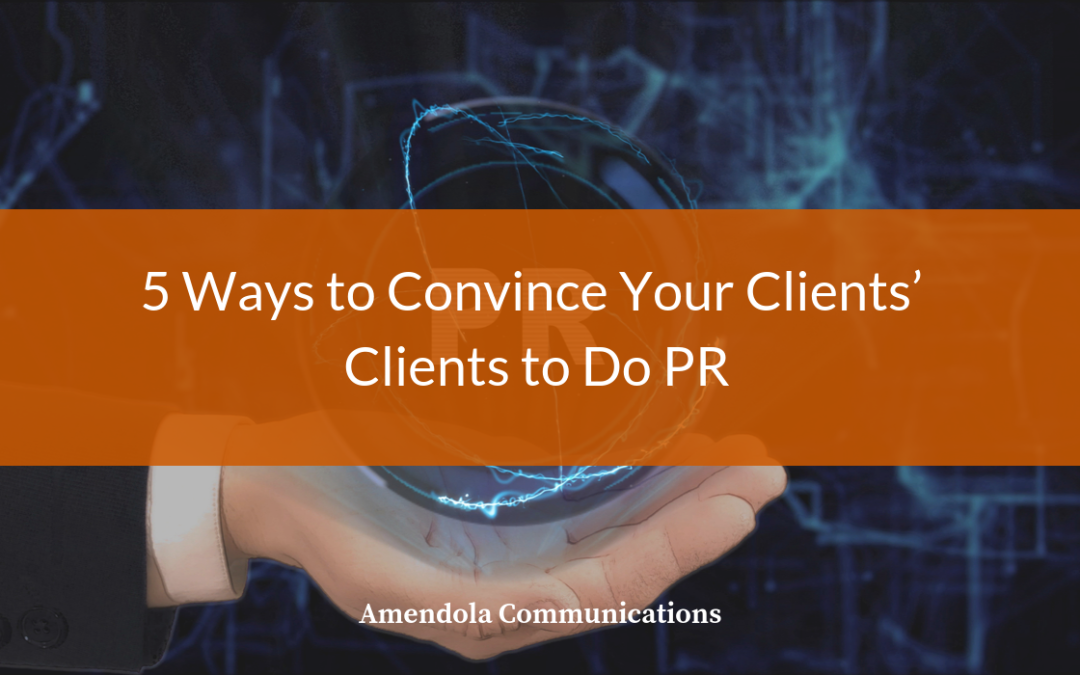
by admin | Oct 9, 2019 | Blog
One of the most enduring challenges many of my clients face is getting their clients on board with a public relations program.
It happens to healthcare vendors all the time.
The sales team inks a major deal with a large health system or a long-time hospital customer reports transformative results with your solution.
These exciting developments course through your company and the promotional machinery is set into motion. Press releases and media alerts are drafted. A steady cadence of pitches for bylines, case studies, and interviews are knitted together into a cohesive, multi-pronged strategy that aligns with concurrent plans developed by marketing, social media, web development, sales and internal communications.
Suddenly, a single e-mail or phone call brings the entire endeavor to a screeching halt. Your customer doesn’t do PR with vendors.
I’ve been burned by that stove a couple of times. What follows isn’t a sure-fire recipe for folding an end-user into your client’s PR program. No such recipe exists. However, with a bit of foresight and planning, you can reduce the chances of a hard no.’
1. Do Your Homework. A big part of PR is relationship building. A quick huddle with your client’s PR department and agency is great for setting boundaries about what they will or won’t participate in. It also helps to have a granular understanding of how that client approaches public relations. For example, many organizations have firm policies against promoting the vendors they use in day-to-day operations. This might imperil the chances of a press release, but could open opportunities for other kinds of content, such as speaking engagements, vendor-neutral interviews and carefully curated thought leadership.
2. Set the Table. Successful end user public relations actually start with the sales team and account managers who onboard new clients. Do your contracts include language about PR participation? Most clients would understandably balk at being required to participate in a full-fledged PR campaign, but many contracts have a line or two mandating that a press release be distributed within 60 to 90 days of signing the contract. Sales teams are also great for understanding the best way to approach a client with a public relations strategy.
3. Sell Their Story. Positive media coverage can be used by the health system to promote this new capability among existing patients and the broader community. As an industry, healthcare is unique in the level of fellowship and collaboration it inspires. Healthcare providers have a passion for sharing new ways to meet complex challenges. Creating a client-centered strategy that focuses on the organization’s journey and perspectives could open more doors than a strategy that blatantly promotes the vendor.
4. Be Strategic, Not Tactical. Any client who is participating in your PR efforts should have a voice in the actual strategy and tactics. This thinking goes beyond press release approval. It includes how and when they will be positioned and prepared for media interviews, speaking engagements, or other opportunities. Establishing a regular cadence and open line of communication with your client’s marketing and PR team ensures that you both make the most of your public relations efforts.
5. Start Small. It’s tempting to be aggressive with new client public relations because the opportunities seem endless. But broad programs are easy to reject. Too much time, too many resources. There’s nothing wrong with creating an ambitious program but reveal as much as you need to at the time. Start with small but measurable wins to build up a relationship.
Your company’s clients are a critical and bountiful resource for your PR and marketing program. They offer third-party validation for the efficacy of your solution within the industry. They act as vendor-neutral sources for editors and reporters in the trade and business press. They provide real-world solidity to the larger trends and narratives impacting healthcare in the United States.
Though your clients may understand the value they could bring to your PR strategy, that doesn’t mean they will go along with it. Communication with your clients about PR initiatives not only clears up misunderstandings but also helps establish with your client boundaries and a level of comfort about deliverables being created with their name and reputation affixed to it
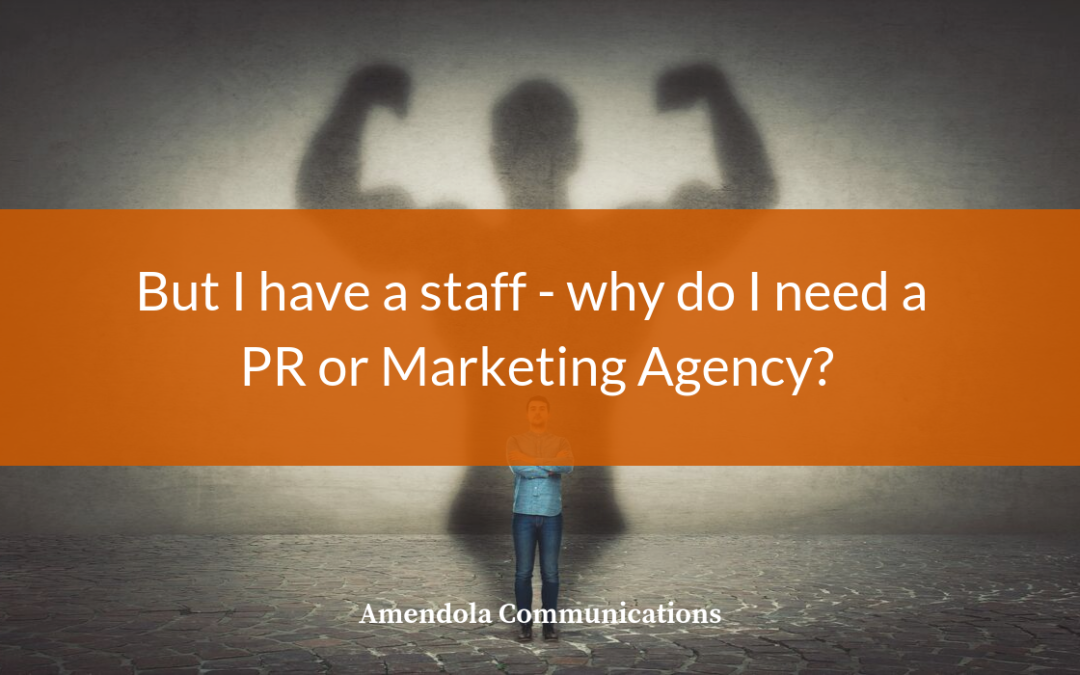
by Stacy State | Oct 2, 2019 | Blog
We all have strengths and whether we admit it or not, we all have weaknesses. For one, I can’t seem to make a grilled cheese sandwich without burning at least one side. Lucky for me, there are people that not only cook grilled cheese to perfection, but they’ve done so well they’ve opened entire businesses to support this one simple menu item.
Outsourcing we all do it, nearly every day. I, for one, often “outsource” my cooking whether it be to family members or to nearby restaurants.
According to Dictionary.com, outsourcing is a verb meaning to purchase (goods) or subcontract (services) from an outside supplier or source. Unfortunately, the word “outsourcing” often sparks a negative connotation. In reality, it’s simply working with others to provide goods or services to enable one to focus on their own strengths.
The Benefits of an Agency
In 2017, the entire outsourcing market was worth $89 billion and has only grown since with both large and small companies outsourcing various components of their business. Frequently, companies choose to outsource all or pieces of their marketing and public relations efforts.
Some reasons companies may choose a marketing and PR agency include:
- It can be difficult to find the best talent, at a reasonable price. Hiring an agency that specializes in your field can afford you multiple experts at a lower cost.
- Faster Turnaround. With domain knowledge and available tools, a team of experts can produce results faster.
- Tools and Technology. An agency has access to the latest marketing and public relations tools and technology required to execute flawless campaigns with robust reporting.
- Staying Focused. This is especially true of smaller companies or high-growth companies. If information technology is your specialty, let your teams focus on internal development and support while outsourcing tasks that supplement your company objectives while allowing your team to stay focused on their initiatives.
- Last, but not least it is often more financially viable to outsource all or pieces of marketing and public relations rather than staff an entire team. Depending on a company’s size and growth trajectory, an internal marketing and PR team may consist of 1-2 or as many as 20+ internal employees.
Leaders must remember that it’s not an “all or nothing” scenario. If you have internal teams to handle most of the marketing and PR efforts, but you need the other 20%-40% managed externally, most agencies can fit your specific needs into a customized plan.
How to Decide
Even as a highly regarded marketing and public relations agency, we recognize that outsourcing these critical business needs is not for everyone. In a recent Forbes article, Jodi Amendola of Amendola Communications discusses the four criteria and questions to ask before choosing an “outsourced” marketing and PR agency.
The four most important questions include:
- Do you have clearly defined goals that you want your agency to achieve?
- Do you have someone that can act as your corporate liaison?
- Is your company’s culture accepting of new ideas and concepts?
- Are you okay with not being completely in control?
The last two are of particular importance. Whether you have an internal marketing staff already or will be relying solely on an agency, the culture of the company and willingness to accept an outside agency as part of your team is the key to success. The more you accept an agency as part of your team the easier it is for your employees and the agency to align with the business objectives and achieve goals.
In the most successful relationships, companies perceive their marketing and PR firms as an extension of their own teams. As with the existing marketing associates, agencies must also be held accountable for achieving defined goals and measured on their successes.
In summary, every company has its strengths and weaknesses. Josh Kaufmann, a famous business and entrepreneurship author, once said, “For everything we don’t like to do, there’s someone out there who’s really good, wants to do it and will enjoy it.” If you can find one of those, you’re ahead of the game.
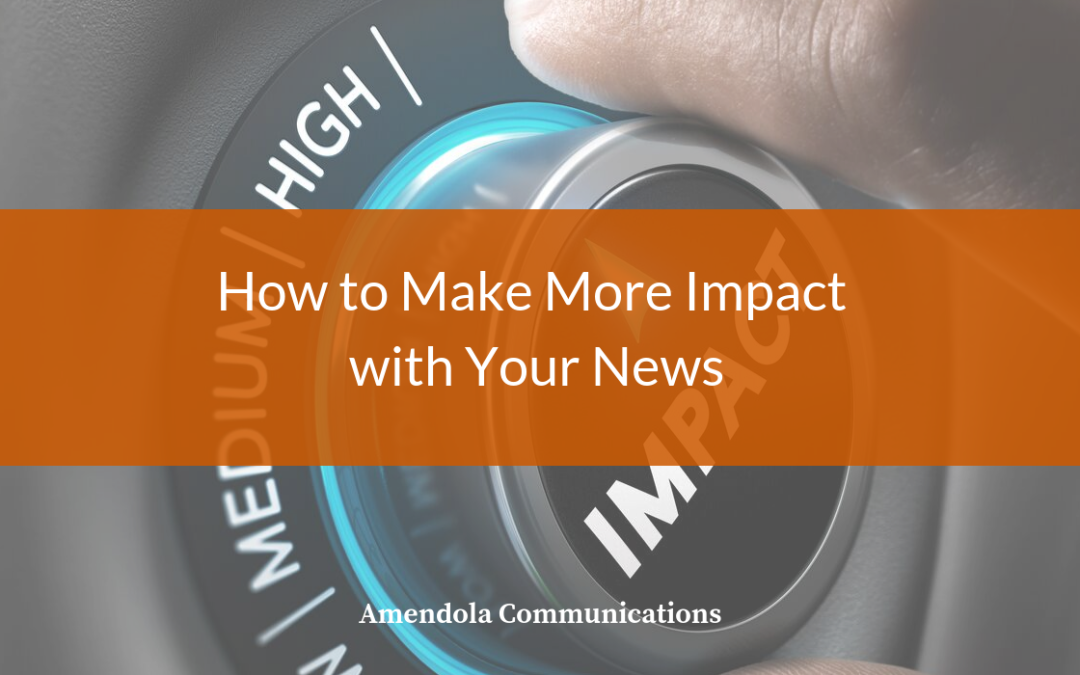
by Chris Currington | Sep 25, 2019 | Blog
You have a piece of fantastic news. Congratulations! But what are you going to do with it now so you can get maximum exposure of it?
We hear many times, “I have a great story, let’s write a press release!” Could be a new solution offering, the latest customer success story, or perhaps even a new hire who has a lot of experience and is of high caliber. This always leads to bigger questions, such as: “How does it fit into your broader marketing efforts?” or “What does publicizing this do for you?”
Anything that is truly newsworthy isn’t a one-off “mention.” It’s what you do with it afterward that creates the bigger buzz and gets the most attraction for your company or organization.
Use it to create broader campaigns
This is especially important for a new solution or product launch. You’ve taken the time to go through the tedious development and testing phases, which is great for the worth of the product. But, do you really just want to issue a press release, or do you want to use the news as a springboard for broader exposure? Consider what you’re going to do after the press release has been issued.
Today, social media and advertising can be excellent ways to capture leads and generate sales. Tie whatever news you’re creating to the appropriate social channels and use them to keep promoting the product offering. And consider how the news translates to the customer journey. If you want to attract customers to your website, ask yourself how you will use the news you create to drive traffic there.
Remember where it falls into integrated marketing efforts
Just because you have a new piece of news doesn’t mean it shouldn’t tie into your broader marketing efforts. Many industry publications provide their annual editorial calendars. These can be incredibly important as you develop your news cycle and combine it with your paid media efforts.
For example, let’s say a trade publication has dedicated its March issue to a topic that matches perfectly with the research being performed by one of your thought leaders. You may want to consider skipping the news you’d planned for him or her in January and wait until the publication’s March issue. This way, not only are you releasing the news publicly, you’re more likely to get an interview by the publication at the same time, increasing the exposure for your thought leader even more.
Keep the next campaign in mind
If you want to use your news as a way to reach your target audiences, consider having a cadence of news releases, and have them coincide with various campaigns. This is a great way to promote your products and/or solutions throughout the year. For example, you can look at your integrated calendar, and have press releases occurring every month. But don’t let the releases stop without further promotions. Have an entire calendar of items happening – and remember that it doesn’t matter if they’re overlapping at various times.
This is also where your automated marketing efforts can produce excellent results. Have a press release prepared, plan to issue it, then follow it up with an infographic that brings people to some form of gated content. Keep doing this throughout the year, and you could possibly have a never-ending list of leads constantly coming to you.
Remember what’s newsworthy and what’s noteworthy
Just because someone comes to you with something they feel is newsworthy doesn’t necessarily mean it is. What’s harder is trying to convince him or her that what they have in mind may not capture their audience as compellingly as they intend. Finding the right outlet may be the best way to convince them that there could be a better – and less time consuming – way.
For example, a company could spend thousands of dollars recruiting a new senior vice president. They find the ideal candidate, with the right education and background, and they want to point that out to their competitors. So they propose a news release. However, industry publications and business journals throughout the country have new-hire and people-on-the-move sections. Perhaps it would be a lot easier writing up something simple, having it placed in one of these outlets, and then promoting on the company’s website and through social media. You may find that you get the same, if not better, results with a lot less effort and expense.
When planning your overall news cycle, keep these things in mind: newsworthiness, breadth, integration and the big-picture campaigns. Don’t let your stories fall flat when there are so many ways to promote them and easily available to you and your organization.
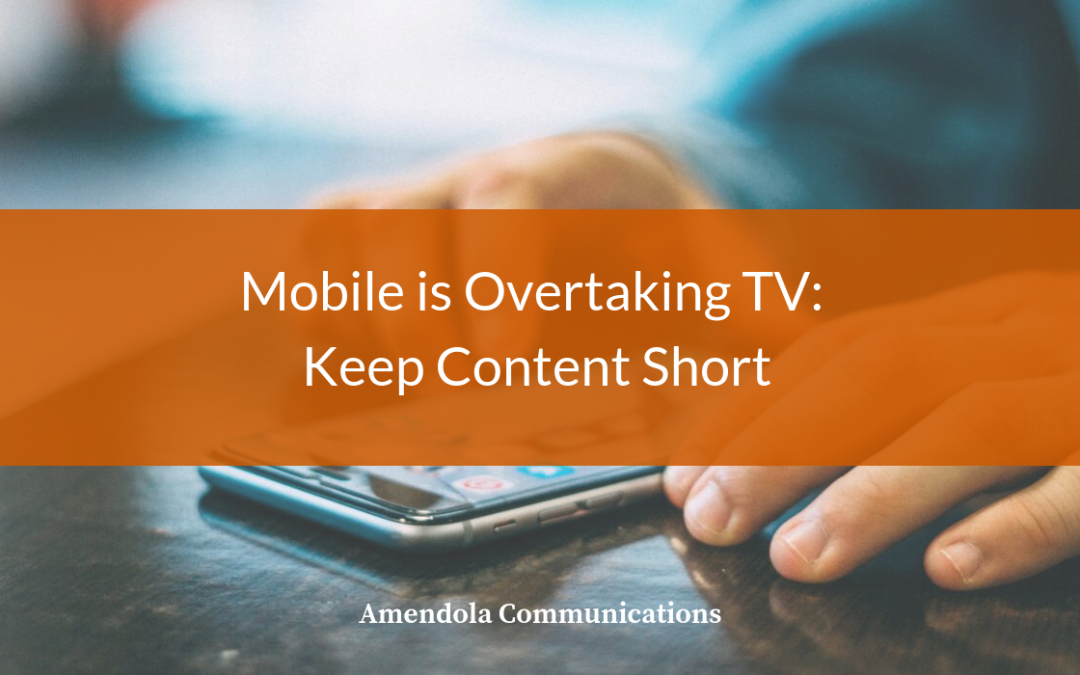
by Morgan Lewis | Sep 18, 2019 | Blog
According to study results that likely surprised no one, Americans now spend more time on mobile devices than watching TV. Research and analysis firm eMarketer estimates that U.S. adults will spend 3 hours, 43 minutes on mobile devices in 2019, just above the 3 hours and 35 minutes spent watching TV. Most of that mobile time, eMarketer determined, will be spent on smartphones.
It does seem that everyone is staring at their smartphone all the time. At airports, restaurants, shopping, home, even while they’re in the car(!), people can’t look away from those alluring handheld devices.
This includes everybody, too, not just the younger than 30 crowd. Eighty-one percent of the U.S. population owns a smartphone, including 53% of seniors age 65 and older. Even my 84-year-old father is enchanted with how well his Samsung Galaxy S8 takes photos of his grandchildren and can accurately transcribe his voice into text messages.
B2B healthcare marketers can take advantage of this mobile omnipresence by ensuring their written content is mobile optimized. That means marketers will need to craft written content that is mostly short, punchy and memorable while driving the reader toward action.
Write to be scanned
With the thumb always on the screen scrolling and scrolling, people don’t read on mobile the same way they do on a desktop. Users jump from one piece of content to the next and one app to the next when they receive a new notification.
That is why writing for mobile needs to top-load the most relevant and interesting points without giving away all the information too soon to keep the reader’s thumb moving all the way to the end. Likewise, due to the smaller screen, writers also need to keep the paragraphs shorter so readers don’t get lost in a long block of text on smaller screens.
The eMarketer study also found that the bulk of the time people spend on their mobile devices is on apps, not web browsers, and typically social media. Customizing content specifically for certain apps, such as LinkedIn or Facebook, is a major consideration. For Twitter, of course, marketers will need to come up with an enticing 280-character-long description of a blog post or article that will link to the content elsewhere.
Long-form for later
Although healthcare leaders typically don’t read long content pieces such as white papers or journal articles on their mobile device, long-form content is in demand.
Survey results from Forbes/Deloitte found that “feature articles and reports” were the most preferred format for business insights among C-level executives. Google, meanwhile, a few years ago reported that 80% of hospital administrators reach out to vendors for more information, including 45% who are researching vendors on their mobile devices.
Through a piece of shorter, scannable mobile content, marketers can improve their chances for further engagement by inviting the healthcare decision-maker to download or have a white paper or eBook emailed to them.
Speaking of eBooks, which are typically a longer-form of content, they can be ideal for mobile device consumption. With fewer words, more graphics and callout boxes that can be easily viewed on a smartphone, marketers can create an attractive, mobile-optimized eBook that is readable during a lunch hour, waiting in an airport or in a rideshare.
Tap into video
Short videos are an ideal content delivery format for mobile devices. If healthcare executives are like their colleagues in other industries, 59% would rather watch a video than read text. Here again, though, at the end of the video, marketers can invite the viewer to learn more by downloading a mobile-friendly eBook, have a white paper emailed to them, or even request a demo. As with written content, however, videos must be short 3 minutes maximum.
If you can’t effectively communicate your message and value proposition to potential customers in 3 minutes, then please give Amendola Communications a call so we can help streamline your messaging and boost its impact. To learn more about’ our strategic counsel, PR or other integrated communications and marketing services, take a look at some of our case studies here.” (See what I did there?)
by admin | Sep 11, 2019 | Blog
Anyone who has ever worked on a rebrand can agree on one thing. It’s a LOT of work.
A rebrand can easily become an arduous process – from finding the right design inspiration to obtaining strategic direction to developing succinct messaging and finally to crafting the right finishing touches to make it all come together. And that’s not taking into account obtaining executive buy-in.
When you initiate and execute a rebrand, you’re not only changing the entire visual identity of your organization, but you’re reintroducing how prospective employees and customers will find, recognize, and perceive you. But fear not. There is a way to make this process and transition – smooth enough to stay connected with your customers, employees, investors, and prospects.
How to know when it’s time to rebrand
- You’ve gone through a merger, acquisition, and/or divestiture
- You’ve recently repositioned your business i.e: new sales strategy, etc.
- Changing markets. Have you exited a former market? If so, your brand identity may no longer make sense for your current target audience.
- Does your brand have a negative reputation? Is your NetPromoter score indicating client dissatisfaction? Have your win/loss studies found clients think your company’s message or position is disjointed?
- Is there market confusion? Does another company have a similar name or brand identity? If so, it’s time to consider differentiating your offering.
- Have there been recent changes to your executive leadership team? With new leadership may come new direction, and thus, a need for a new brand.
- Is your logo/brand identity outdated or stale amongst your competition?
If you’ve answered YES to one or more of the questions above, it’s time to consider moving forward with a rebrand.
We need a Rebrand. Now What?
Audit. And audit once again.
Before you get too far over your skis, it’s helpful to conduct a thorough brand audit. This will improve the odds of success and ensure you’re operating from a place of “knowing” rather than “assuming” when it comes to the many, many aspects of your rebrand.
Through the execution of surveys, customer interviews, a brand sentiment analysis, and comparisons of NetPromoter Scores, you will gain a clearer understanding of how your organization is performing. Understanding where you are today will then enable a more informed decision-making process to get you where you want to be.
Build for change.
The struggle is real when it comes to building for change. During one particular rebrand I worked on, the healthcare technology company spent millions of dollars rebranding their organization to give themselves a “fresh look” without taking one major consideration into play.
Healthcare and technology are two of the fastest growing and ever-evolving markets in the United States economy. Suffice it to say, things change. Quickly.
After only six months of phase one roll out, they quickly realized their business model was changing due to a planned acquisition and the new branding no longer fit the expanded offering of the organization. They had inadvertently pigeonholed themselves into a brand they outgrew at a rapid pace.
My client had to invest even more time, resources and funding to ensure the second phase of their rebrand delivered a result that was not rigid or fixed. The most successful rebrands are built to withstand the test of time, allowing for the ebb and flow that is guaranteed when you’re operating in a consistently changing landscape.
A Get real.
The best brands keep it real. Honesty goes a long way just think about the credibility McDonald’s earned years ago when they decided to reveal the ingredients in their burgers and French fries. Brands who stand for something also gain traction among clients and prospects.
Patagonia, the outdoor clothing and gear brand with a cult-like following, saw a jump in their annual revenue to the tune of $600 million after going public with their ecological sustainability initiative.
Whatever your “real” is, be that. Let’s get away from stale websites chock full of stock images, basic color palettes, and over-used marketing buzzwords. I think we’ve all read about innovative technology, tangible results, and dedicated account management.
Instead, use your brand as a springboard to add colorful depth to your offerings. Change the conversation. Create meaningful relationships. And carve out such a unique position for your brand that it becomes more effortless to rally your employees, customers, and investors behind that voice.
“A brand is no longer what you say about yourself. It’s really what a friend tells a friend.” Tina Sharkey, co-founder of Brandless




